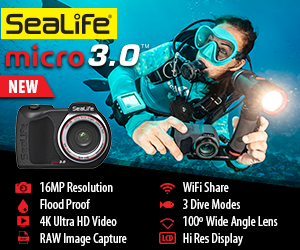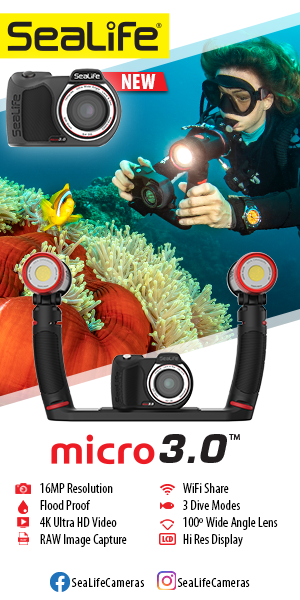Dive lights are necessary for you to see at night underwater; they’re also your principle means of communication at night. In the daytime they come in handy for lighting places where the sun doesn’t reach — overhangs, crevices, swim-throughs — and for those trained in overhead environments, wrecks, caverns and caves.
Dive lights come in many shapes, sizes and purposes — large and small, wide beam and narrow beam, electric and chemical. They’re powered by one-charge batteries, rechargeable batteries or even separate battery packs. Some lights have handles or pistol grips, some fit in the palm of your hand and others strap to your head. And they’re useful above water as well as below.
Regardless of what types of dive lights you choose, the principles of using and caring for them are the same.
Predive and Post-dive Care
A dive light is as much a part of your scuba equipment as your buoyancy compensator (BC) and regulator. And every piece of equipment requires diligent care and maintenance to function reliably for an extended period.
At the same time you inspect your primary gear in preparation for diving, make sure to include your dive lights. Open the light and check the user-serviceable O-rings, usually found around the battery compartment cap and perhaps the bulb compartment. They should be free of debris and nicks or cuts. If specified in the manufacturer’s material, apply a small amount of silicone grease until the O-ring is shiny but smooth.
Work the switch and lock to confirm that it moves freely. Insert a fresh set of alkaline batteries or fully charged rechargeables to ensure a strong beam throughout the dive. Test the light to make certain you’ve put the batteries in the correct direction and the bulb is good. Lastly, attach a lanyard or strap to fasten the light to your wrist or gear so it won’t be lost in case you drop it.
During the dive avoid dragging the light along the sandy bottom or banging it on hard substrate. Even if you have the light strapped to your wrist with a lanyard, carry it in one hand to prevent it from swinging free.
Afterward, soak and rinse in fresh water as soon as possible. With the light in the fresh water, work the switches to dislodge trapped particles. Dry the light out of the sun. Don’t open it until it is completely dry and you are sure no water can splash inside. Remove the batteries for recharging or replacement. Store with your other scuba equipment.
Choosing a Light
Well-equipped divers carry at least two lights — a primary and a backup. As reliable as they are, it is still important to have an alternate in case of light failure or loss during a dive. Many divers have several to choose from depending on conditions.
Conventional wisdom suggests that the primary light be as powerful as possible to illuminate a wide and deep arc. These will be relatively heavy lights — what my buddies and I used to call “57 Chevys,” since their beams resembled huge headlights underwater. They usually take six or more D-cell batteries or a pack of rechargeables.
This may be appropriate in turbid water, inside wrecks and when searching for a particular landmark. However, in clear water at night a much smaller primary light better suits the purpose.
Night creatures prefer the dark; they use it to feed in relative safety or to hunt for prey. When you shine a bright light in their direction they either instantly disappear or zip frantically around, often bumping into objects in their terrified race for shelter.
A less powerful light is less likely to cause flight — especially if you keep the creatures in the periphery of the beam instead of in the central hot spot. It will also illuminate a more compact area. Divers tend to cover a much smaller area at night; a 6-foot (2-m) arc is plenty to allow you to see ahead and to the sides.
The backup light is typically smaller than the primary. It is good for shining into shadowy niches in the daytime and can often be carried in a pocket. Underwater photographers often use their modeling light(s) as a backup. These are pinpoint lights that are either built into strobes or strapped to them to aid in aiming the strobes at a subject.
For a number of years chemical glow sticks attached to the regulator yolk were commonly used to find divers in the dark, especially on group night dives. Nowadays, environmental concerns have prompted a switch to attaching small, battery-operated signal lights, which come in different color lenses.
Lights are also used as navigation aids. A flashing white strobe is often hung below the boat to help divers locate its position. When diving from shore, two beacons can be placed — one near the water and one visible at a distance. When lined up, these guide a diver to the exit point.
Signaling
In addition to lighting your way underwater at night, a dive light is also necessary for communication. It is used to illuminate standard diver hand signals and to make light signals.
The first rule of using a dive light underwater is to never shine it at another diver’s face. That may attract his or her attention, but all he’ll see is a point of bright light coming from your direction. He won’t thank you for ruining his night vision until his eyes readjust to darkness.
Sometimes divers accidentally make this rookie mistake while trying to illuminate their hand signals. For instance, they hold up one hand in the thumb-to-index-finger “OK” signal. Realizing their buddy can’t see their hand, they shine their light on it — from the near side. The light beam does illuminate the signal in silhouette, but it also shines past the hand signal right at their buddy. To see the signal, the buddy has to look straight at the light beam.
Instead, hand signals should be illuminated from the far side back toward you. Make the signal with your hand close in front of your chest. Point your light back toward your chest and the signal at an angle, creating a clear view of the signal for your buddy.
So how do you attract your buddy’s attention at night? You can bang on your tank or use a noisemaker, but it is even more difficult to tell where the sound is coming from when you can’t see the person making it. Instead, or in addition to an audible signal, you use your light.
At night, buddies should remain close enough to each other that the beams of their dive lights can overlap. To attract your buddy’s attention, move your light rapidly back and forth across your buddy’s light beam. Back and forth — horizontal — movement signals “I want your attention.” Up and down — vertical — movement, however, signals danger or emergency.
Dive lights are also used for signaling from the surface at night. Here also, the light beam is pointed at yourself unless you are trying to attract attention from a distance. Signal “OK” using the one or two arm(s) over the head technique, pointing the beam of your light down toward your body. (For more information, see “Final Check: What it Looks Like When … You Are Seen at Night,” Dive Training, April 2005.) If you are in distress, point your light toward the boat or shore and wave it back and forth over your head.
Dive lights are an essential item of equipment for the well-prepared scuba diver; you can’t dive at night without them and they add color and excitement to daytime dives. Choose lights that best suit your type of diving and take care of them as you do the rest of your gear.
By Linda Lee Walden




